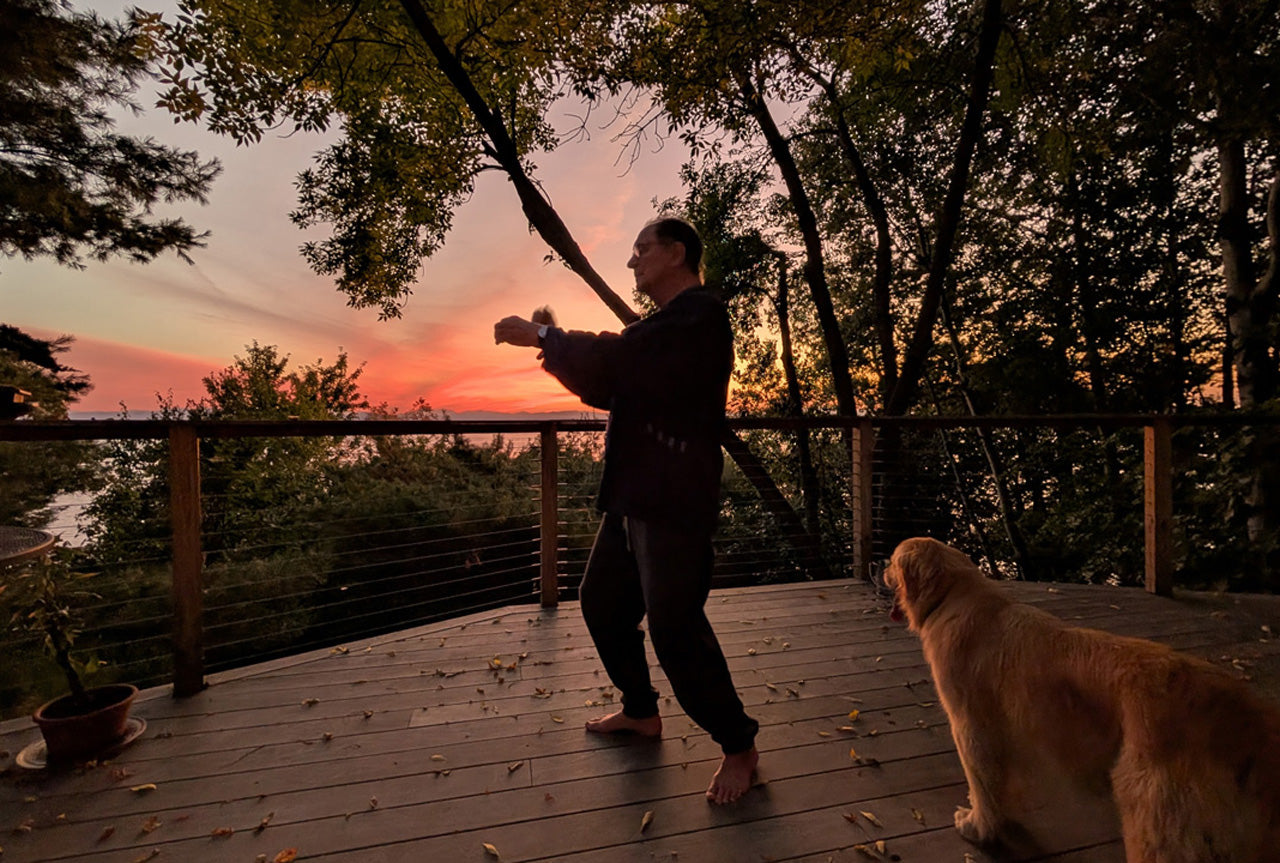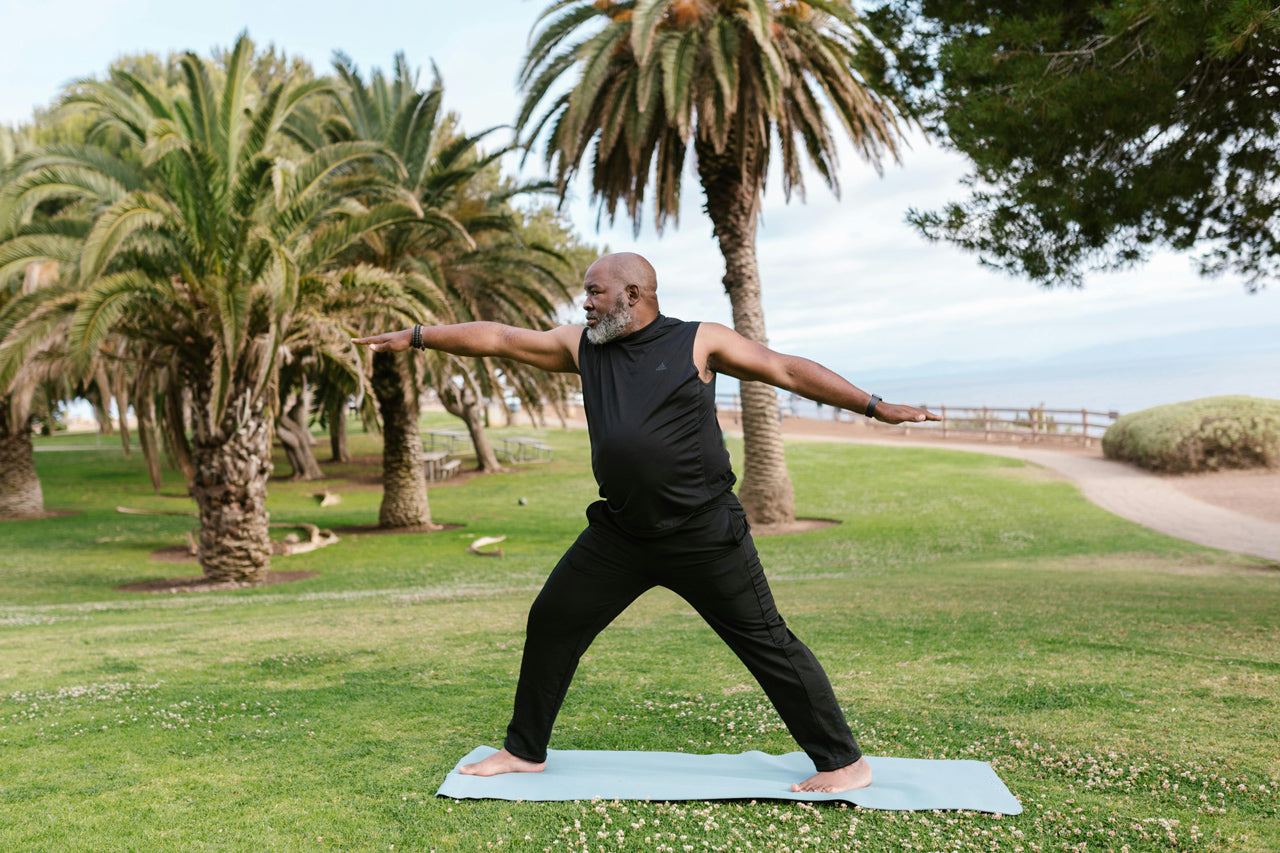Tai Chi is an ancient practice long believed to have health benefits, a view that has been confirmed in over a thousand peer reviewed studies over the last two decades. Modern research methods find that Tai Chi improves strength and health and extends life span, in effect providing more years as a younger person.
Tai Chi in the Eyes of Modern Medicine
Tai Chi began centuries ago as a martial art in China, but early on the health benefits of Tai Chi were also recognized. About 200 years ago Yang Lu-ch’an added this footnote to the Tai Chi classics: “This classic was left by the patriarch Chang San-feng of Wu Tang Mountain who desired the whole world to attain longevity and not only martial techniques.”
The transition from a secretive martial art to a global wellness practice was at first gradual, but accelerated in the 20th century when the Chinese government began to promote Tai Chi first as a national martial art and then a decade later as a way of improving overall health. By the 1960’s Tai Chi had made the leap to the West and was being taught from San Francisco to NY City.
But it wasn’t until the 1980’s that the research tools of modern medicine and epidemiology were used to better understand the health benefits of Tai Chi. Remarkably, over the last 50 years there have been more than 1,000 peer reviewed studies examining Tai Chi, and about half of these were randomized controlled trials, the gold standard in medical research. Moreover, some of these studies have been published in the world’s most prestigious journals such as the New England Journal of Medicine, JAMA, and The Lancet.
So, quite a lot of interest from serious researchers. What has Western medicine learned about Tai Chi?
Physiology and Anatomy
To understand health and disease Western medicine relies on the study of both physiology (the chemical and electrical workings of the body) and anatomy, and Tai Chi produces measurable changes in both. Physiologically, Tai Chi modestly increases heart and respiratory rates. It also increases parasympathetic tone, reduces sympathetic tone, and promotes nitric oxide release, changes that together reduce blood pressure, increase heart rate variability (HRV), and enhance function of the cells that line blood vessels. Increased HRV is of particular interest, because is associated with cardiovascular health and resilience, qualities that are in turn associated with decreased all-cause mortality.1
At the cellular level there is some evidence that Tai Chi increases telomerase activity and reduces chronic inflammation by modulating the hypothalamic-pituitary-adrenal (HPA) axis, decreasing cortisol levels2, and downregulating nuclear factor-κB (NF-κB) inflammatory pathways. Finally, Tai Chi enhances immune system function, improving immune surveillance and modulating inflammatory responses.3
Importantly, Tai Chi can produce significant metabolic changes during a single 30-minute session. Although the exact mechanism is unclear, researchers found that serum glucose, insulin level and insulin resistance were enhanced, whereas the cholesterol, HDL-C and ET-1 levels were reduced 30 min after TCC practice.4
Turning to anatomy, over time Tai Chi produces increases in leg strength, particularly the quadriceps and tibialis anterior, changes that together help with dynamic knee joint alignment, and improve rotational stability.5 Tai Chi also produces changes in brain structure and function, including increased grey matter volume in motor control regions and enhanced cortical-muscular coupling.6
So, quite a list of changes, which can in turn provide a number of health benefits. What follows is a partial list of conditions that Tai Chi can help ameliorate.
Balance
We know that balance degrades with age, and preventing this loss is important because falls are common in the elderly, falls that can start a downward spiral leading to a catastrophic outcome. Each year 30% of people over the age of 65 have a fall. Tragically, these falls cause are associated with 40,000 deaths and cost to our health care system of almost $100 billion each year. Still worse, despite improvements in health care, for unclear reasons the mortality from falls continues to rise, almost doubling over the last 20 years7.
Because Tai Chi involves balance training the hope that Tai Chi might prevent falls was top of mind for researchers. In 1996 Wolf et. al studied this question using a randomized controlled design involving 200 people aged 70 and older, and their results were striking: the group practicing Tai Chi had a 50% reduction in falls. This finding was felt so important that Wolf’s paper has now been cited over 1700 times in other peer reviewed articles. Moreover, it is now clear that better balance was the cause of reduced falls.8 A separate paper published the following year, Vellas and co-workers found that the inability to balance on one leg for more than 10 seconds was a powerful predictor if injurious falls. So, the causal chain was established: “Tai Chi -> better balance -> fewer falls.9
While fall prevention is a singular benefit, researchers have documented a host of other health improvements that Tai Chi provides.10,11
Cardiovascular
Tai Chi significantly affects the cardiovascular system. Regular practice is associated with lower systolic blood pressure, as shown by randomized trials in both healthy adults and those with prehypertension or cardiovascular risk factors.12 Tai Chi also improves heart rate variability—an indicator of autonomic nervous system balance and cardiovascular resilience13—while increasing VO2 max, the standard measure of cardiorespiratory fitness14. In a 2022 head-to-head comparison between Tai Chi and moderate-intensity running exercise, Tai-Chi exercise produced similar improvements in cardiorespiratory fitness, resting health rate, blood pressure and lean mass, although running appears to have further benefit of reduced blood lipid levels.15
Sarcopenia
All humans naturally lose muscle mass as they grow older starting around age 30, a phenomenon called sarcopenia. Although gradual, sarcopenia is relentless with most men and women losing 3% to 8% of their muscle mass with each passing decade, a rate that accelerates to 1% -2% each year after the age of 60. This process is poorly understood, but contributes to functional decline and metabolic dysfunction, reducing quality of life and increasing all-cause mortality.16
Because sarcopenia is universal and can have devastating consequences, finding a treatment has been a priority. Unfortunately, resistance training and ensuring adequate protein intake (1.2 – 1.5 g/kg/day) are the only proven effective interventions; there is no “magic pill”.17
Tai Chi may be an adjunct to combatting sarcopenia, however. Recently, a randomized controlled trial found that 12-24 weeks of Tai Chi practice can improve muscle strength (particularly grip strength and lower extremity strength), enhance neuromuscular responses, and improve physical performance measures (the 30-second chair stand test and timed up-and-go test) in elderly patients with sarcopenia.18 While we might expect Tai Chi to improve lower body strength, it is perhaps surprising that Tai Chi would also increase grip strength19; perhaps this simply reflects Tai Chi’s impact on overall body health.
Bone Health
Tai Chi retards age-related bone loss. A landmark 2004 randomized controlled trial by Chan et al. found that postmenopausal women practicing Tai Chi experienced a 2.6- to 3.6-fold retardation of bone loss in weight-bearing bones compared to sedentary controls over 12 months.20 More recently, a 2025 meta-analysis of 17 randomized trials with 1,253 participants also found improvements in bone density at multiple sites, with the greatest benefits occurring in adults ≥60 years practicing ≥3 sessions per week for ≥6 months. These bone-protective effects appear to work through multiple mechanisms including reduced bone resorption markers and enhanced weight-bearing stimulus.21
Low Back Pain
Low back pain is an almost universal experience, and despite decades of research is still poorly understood by Western medicine. Chronic severe back pain affects over 30 million Americans, and is one of the leading causes of missed work, costing $200-300 billion per year in the United States considering both direct medical costs and indirect productivity losses.
While our understanding of low back pain remains rudimentary, Tai Chi has nevertheless been shown to be helpful in both preventing and treating chronic low back pain. Hall and co-workers found Tai chi exercise reduced intrusiveness of back symptoms, reduced pain, and improved self-report disability at levels considered meaningful by both researchers and patients.22 Researchers speculate that improvements are due to improved spinal alignment and core stabilization, enhanced neuromuscular control of deep spinal muscles, increased flexibility and range of motion, and better proprioceptive awareness, which collectively reduce abnormal spinal loading and muscular tension patterns that contribute to chronic back pain.23
Arthritis
Knee osteoarthritis (“wear and tear arthritis”) (KOA) is a common disorder which can be debilitating, and prompts almost 1 million total knee replacement operations in the USA each year. A recent meta-analysis of 5 randomized controlled trials24 found that Tai Chi practice moderately improved pain, physical function, and stiffness, and recommended Tai Chi as an adjuvant treatment for patients with KOA. A 2025 biomechanical study25 suggested multiple mechanisms for these improvements, including optimized joint kinematics, reduced abnormal knee extension moments, enhanced neuromuscular coordination, and improved rotational stability during gait, which collectively reduce pathological joint stress and slow disease progression. The authors concluded “Tai Chi demonstrated significant clinical and biomechanical benefits for elderly KOA patients, suggesting its potential as a safe, accessible, and effective therapeutic intervention.”
Parkinson’s Disease
Parkinson’s disease (PD) is a devastating, progressive neurodegenerative disorder characterized by the loss of dopamine-producing neurons in the midbrain, causing tremor, rigidity, slowed body movements, and postural instability, as well as cognitive decline, sleep disorders, and autonomic dysfunction. Parkinson’s cases are rapidly increasing, with 25.2 million cases expected worldwide by 2050. The cause is unknown and there is no cure. Current treatments include dopamine replacement, deep brain stimulation, and physical therapy, approaches that provide some relief of symptoms but do not slow the progression of the disease.
Tai Chi can be a helpful adjunct to treating Parkinson’s disease by improving motor function, balance, and gait, and thus helping to preventing falls. A 2012 study published by Li et al. in the New England Journal of Medicine26 found that 24 weeks of Tai Chi training in 195 PD patients produced superior postural stability, reduced falls by 53% compared to stretching, and maintained benefits at 3-month follow-up. More recently, Li et al. (2024) demonstrated that regular Tai Chi practice was associated with slower disease progression, reduced medication requirements, and fewer complications compared to standard care. Tai Chi thus seems to be a safe and effective adjunct that can help with both motor and non-motor symptoms of Parkinson's disease while potentially slowing overall disease progression.27
Mental Health
A recent large meta-analysis from researchers at Tufts Medical Center28 reviewed a total of forty peer reviewed studies. While not all studies included had adequate controls, the analysis concluded that Tai Chi was associated with improvements in overall psychological well-being, including reduced stress, anxiety, depression and mood disturbance. Although the authors do not speculate, the improvements seen in these studies likely stem from a variety of factors including enhanced mindfulness, improved self-efficacy and progressive skill mastery, as well as the social connection benefits that come from any group practice.
All-Cause Mortality
The most basic measure of any health practice is its impact on mortality and lifespan. Epidemiologists put great store by a basic measure, all-cause mortality, typically reported as an odds ratio. We know that any form of exercise reduces mortality, and a 2013 study in the American Journal of Epidemiology confirmed this basic finding. Interestingly, the effects of walking, jogging and Tai Chi were indistinguishable, with each practice reducing mortality by about 20%, a very large reduction compared to most other health-promoting interventions.29 This odds ratio corresponds to approximately 2.5 years of added lifespan30. By way of comparison, curing all forms of cancer would produce an almost identical 2.5-year reduction in all-cause mortality.
The “Dose” of Tai Chi
If we think about Tai Chi as a medical therapy, we might ask what the optimal “dosage” is. Researchers have typically studied the effect of initiating three one-hour sessions per week. Although this dose is likely based simply on the convenience of researchers and subjects,31 it may also reflect the 500-700 MET-minutes of effort per week that is recommended for overall cardiovascular fitness.32
Importantly, all of the studies cited so far are short-term studies of what happens in the weeks and months following the initiation of Tai Chi practice. What about the longer term?
Fortunately, a few studies have examined the long-term practice question by comparing experienced practitioners to age-matched sedentary controls. A comprehensive study from 2023, Wayne and co-investigators found that Tai Chi experts with an average of 24.5 years of practice performed significantly better than their peers on measures of balance, mobility, and strength, with their functional abilities falling intermediate between young adults and sedentary older adults. The authors suggest that a lifetime of practice leads to functional abilities that are as much as 10 years younger than age matched controls. Importantly this isn’t just more years, it’s more years as a younger person.
Cross-sectional studies also demonstrate that long-term practitioners maintain superior cardiovascular fitness, executive cognitive function, dynamic balance, and quality of life compared to non-practitioners, with clinically meaningful effect sizes. These studies also confirm the mortality benefits observed in large cohort studies, showing a 20% reduction in risk of death among regular Tai Chi practitioners. Thus, the cumulative benefits of decades-long practice seem to help successful aging and longevity.
Because there is little research specifically about how much or how often to practice Tai Chi, it may be best to simply rely on the accumulated experience of generations of Tai Chi teachers. The Tai Chi Classics recommend twice daily practice, morning and evening, and emphasize the importance of consistent practice.
Finally, we might ask at what age should one begin practicing Tai Chi? Here there is no peer reviewed research, but we could turn to an old Chinese proverb about planting trees: “The best time to plant a tree was 20 years ago; the second-best time is now.”

Cardio, Resistance Training, and Tai Chi
We’ve long known that humans require exercise to remain healthy, although curiously we don’t really understand why. Our primate cousins (chimps, bonobos, orangutangs, etc.) remain healthy with very little exertion. But we humans need exercise, and so interest has focused on what type of exercise might be most beneficial.
In the United States interest initially focused on cardio as the optimal exercise, kicked off by Dr. Kenneth Cooper's 1968 book "Aerobics," which declared aerobic activities like running and cycling to be "the key to overall physical health". Cardio reigned through the 1980’s when 22 million Americans were running and doing dance based cardio workouts. More recently the pendulum has swung, however, and it’s now believed that strength training is also important for long-term health because resistance training more effectively builds muscle and bone density than pure cardio workouts. Most authorities now take a middle position and recommend a combination of cardio and resistance training.
Tai Chi offers a different perspective, ignoring the cardio-versus-strength dichotomy by combining modest cardiovascular activity with sustained muscular engagement while bringing explicit attention to balance, body integration, and mindfulness. As a result, Tai Chi provides a more complete package of both health benefits and better overall physical function.
Finally
The type of exercise one embraces is much less important than the fact that one exercises. And so it may be that the best form of exercise is simply the one that you find most appealing, because that’s the pursuit you’re most likely to pursue, day after day, week after month after year. Note also that your optimal form of exercise may change as you age, so it’s important to be alert to new possibilities. It’s never too late to take up weight training, and it’s never too soon to begin Tai Chi.
Coda
Tai Chi is big topic, so the above essay is necessarily brief and somewhat selective. For those wishing to look more deeply into individual medical conditions the table below lists the major conditions for which Tai Chi is felt to be helpful as well as those where it unlikely to be of help, along with a peer-reviewed reference that may serve as a starting point.
Key References Used:
- Wayne PM & Kaptchuk TJ (2016). "Health benefits of tai chi: What is the evidence?" Can Fam Physician - Comprehensive review of 500+ trials
- Solloway MR et al. (2016). "Evidence Map of Tai Chi" - Systematic review of 107 systematic reviews
- Multiple condition-specific systematic reviews and meta-analyses from PubMed/PMC
Note: The "Not Helpful" classification is based on Wayne & Kaptchuk's 2016 comprehensive review which found "no direct benefit" for these three conditions despite extensive research. However, these conditions
1 Tan JPH, Beilharz JE, Vollmer-Conna U, Cvejic E. Heart rate variability as a marker of healthy ageing. Int J Cardiol. 2019 Jan 15;275:101-103. doi: 10.1016/j.ijcard.2018.08.005. PMID: 30104034.
2 Nedeljkovic, M., Ausfeld-Hafter, B., Streitberger, K., Seiler, R., & Wirtz, P. H. Taiji practice attenuates psychobiological stress reactivity: A randomized controlled trial in healthy subjects. Psychoneuroendocrinology. 2012. doi:10.1016/j.psyneuen.2011.11.024.
3 Oh B, Bae K, Lamoury G, Eade T, Boyle F, Corless B, Clarke S, Yeung A, Rosenthal D, Schapira L, Back M. The Effects of Tai Chi and Qigong on Immune Responses: A Systematic Review and Meta-Analysis. Medicines (Basel). 2020 Jun 30;7(7):39. doi: 10.3390/medicines7070039. PMID: 32629903.
4 Lu WA, Chen YS, Wang CH, Kuo CD. Effect of a Single Session of Tai Chi Chuan Practice on Glucose and Lipid Metabolism and Related Hormones. Life (Basel). 2020 Aug 9;10(8):145. doi: 10.3390/life10080145. PMID: 32784834.
5,25 Pan J, Xie Z, Ye S, Shen H, Huang Z, Zhang X, Liao B. The effects of Tai Chi on clinical outcomes and gait biomechanics in knee osteoarthritis patients: a pilot randomized controlled trial. Sci Rep. 2025 May 27;15(1):18495. doi: 10.1038/s41598-025-03943-3. PMID: 40425665.
6 Cui, L., Yin, H., Lyu, S. et al. Tai Chi Chuan vs General Aerobic Exercise in Brain Plasticity: A Multimodal MRI Study. Sci Rep 9, 17264 (2019).
7 Garnett, M. F., Weeks, J. D., & Zehner, A. M. Unintentional fall deaths in adults age 65 and older: United States, 2023. NCHS Data Brief No. 532. National Center for Health Statistics. 2025.
8 Cui Z, Xiong J, Li Z, Yang C. Tai chi improves balance performance in healthy older adults: a systematic review and meta-analysis. Front Public Health. 2024 Nov 11;12:1443168. doi: 10.3389/fpubh.2024.1443168. PMID: 39588165.
9 Chen W, Li M, Li H, Lin Y, Feng Z. Tai Chi for fall prevention and balance improvement in older adults: a systematic review and meta-analysis of randomized controlled trials. Front Public Health. 2023 Sep 1;11:1236050. doi: 10.3389/fpubh.2023.1236050. PMID: 37736087.
10,31 Lan C, Chen SY, Lai JS, Wong AM. Tai chi chuan in medicine and health promotion. Evid Based Complement Alternat Med. 2013;2013:502131. doi: 10.1155/2013/502131. PMID: 24159346.
11 Wang, C., Collet, J. P., & Lau, J. The effect of Tai Chi on health outcomes in patients with chronic conditions: A systematic review. Arch Intern Med. 2004;164(5):493-501.
12 Li X, Chang P, Wu M, Jiang Y, Gao Y, Chen H, Tao L, Wei D, Yang X, Xiong X, Yang Y, Pan X, Zhao R, Yang F, Sun J, Yang S, Tian L, He X, Wang E, Yang Y, Xing Y. Effect of Tai Chi vs Aerobic Exercise on Blood Pressure in Patients With Prehypertension: A Randomized Clinical Trial. JAMA Netw Open. 2024 Feb 5;7(2):e2354937. doi: 10.1001/jamanetworkopen.2023.54937. PMID: 38335001.
13 Zhou Y, Wang Q, Larkey L, James D, Cui H. Tai Chi Effects on Heart Rate Variability: A Systematic Review and Meta-Analysis. J Integr Complement Med. 2024 Feb;30(2):121-132. doi: 10.1089/jicm.2022.0682. PMID: 37695835.
14 Yang YL, Wang YH, Wang SR, Shi PS, Wang C. The Effect of Tai Chi on Cardiorespiratory Fitness for Coronary Disease Rehabilitation: A Systematic Review and Meta-Analysis. Front Physiol. 2018 Jan 4;8:1091. doi: 10.3389/fphys.2017.01091. PMID: 29354065.
15 Wang Y, Guo X, Liu L, Xie M, Lam WK. Effects of Tai-Chi and Running Exercises on Cardiorespiratory Fitness and Biomarkers in Sedentary Middle-Aged Males: A 24-Week Supervised Training Study. Biology (Basel). 2022 Feb 26;11(3):375. doi: 10.3390/biology11030375. PMID: 35336749.
16 Walston JD. Sarcopenia in older adults. Curr Opin Rheumatol. 2012 Nov;24(6):623-7. doi: 10.1097/BOR.0b013e328358d59b. PMID: 22955023.
17 Kim D, Morikawa S, Miyawaki M, Nakagawa T, Ogawa S, Kase Y. Sarcopenia prevention in older adults: Effectiveness and limitations of non-pharmacological interventions. Osteoporos Sarcopenia. 2025 Jun;11(2 Suppl):65-72. doi: 10.1016/j.afos.2025.05.005. PMID: 40718352.
18 Bai X, Xiao W, Soh KG, Agudamu, Zhang Y. 12-week concurrent brisk walking and Taijiquan (Tai Chi) improve balance, flexibility, and muscular strength of Chinese older women. PLoS One. 2023 Oct 26;18(10):e0293483. doi: 10.1371/journal.pone.0293483. PMID: 37883372.
19 Wehner C, Blank C, Arvandi M, Wehner C, Schobersberger W. Effect of Tai Chi on muscle strength, physical endurance, postural balance and flexibility: a systematic review and meta-analysis. BMJ Open Sport Exerc Med. 2021 Feb 5;7(1):e000817. doi: 10.1136/bmjsem-2020-000817. PMID: 33614126.
20 Chan K, Qin L, Lau M, Woo J, Au S, Choy W, Lee K, Lee S. A randomized, prospective study of the effects of Tai Chi Chun exercise on bone mineral density in postmenopausal women. Arch Phys Med Rehabil. 2004 May;85(5):717-22. doi: 10.1016/j.apmr.2003.08.091. PMID: 15129394.
21 Cui J, Qian C, Liu Y. Effect of Tai Chi on Bone Mineral Density in Middle-Aged and Older Adults: A Meta-Analysis. Orthop Rev (Pavia). 2025 Jul 18;17:142059. doi: 10.52965/001c.142059. PMID: 40688454.
22 Hall AM, Maher CG, Lam P, Ferreira M, Latimer J. Tai chi exercise for treatment of pain and disability in people with persistent low back pain: a randomized controlled trial. Arthritis Care Res (Hoboken). 2011 Nov;63(11):1576-83. doi: 10.1002/acr.20594. PMID: 22034119.
23 Sotiropoulos S, Papandreou M, Mavrogenis A, Tsaroucha A, Georgoudis G. The Effects of Qigong and Tai Chi Exercises on Chronic Low Back Pain in Adults: A Systematic Review and Meta-Analysis of Randomized Controlled Trials. Cureus. 2025 May 18;17(5):e84342. doi: 10.7759/cureus.84342. PMID: 40530198.
24 Lauche R, Langhorst J, Dobos G, Cramer H. A systematic review and meta-analysis of Tai Chi for osteoarthritis of the knee. Complement Ther Med. 2013 Aug;21(4):396-406. doi: 10.1016/j.ctim.2013.06.001. PMID: 23876571.
25 Li, Fuzhong; Harmer, Peter; Fitzgerald, Kathleen; Eckstrom, Elizabeth; Stock, Ronald; Galver, Johnny; Maddalozzo, Gianni; Batya, Sara S. Tai Chi and Postural Stability in Patients with Parkinson’s Disease. N Engl J Med. 2012;366(6):511-519. doi:10.1056/NEJMoa1107911.
26 Li G, Huang P, Cui S, He Y, Tan Y, Chen S. Effect of long-term Tai Chi training on Parkinson's disease: a 3.5-year follow-up cohort study. J Neurol Neurosurg Psychiatry. 2024 Feb 14;95(3):222-228. doi: 10.1136/jnnp-2022-330967. PMID: 37875337.
27 Wang C, Bannuru R, Ramel J, Kupelnick B, Scott T, Schmid CH. Tai Chi on psychological well-being: systematic review and meta-analysis. BMC Complement Altern Med. 2010 May 21;10:23. doi: 10.1186/1472-6882-10-23. PMID: 20492638.
28 Wang N, Zhang X, Xiang YB, Li H, Yang G, Gao J, Zheng W, Shu XO. Associations of Tai Chi, walking, and jogging with mortality in Chinese men. Am J Epidemiol. 2013 Sep 1;178(5):791-6. doi: 10.1093/aje/kwt050. PMID: 23813700.
29 Tsai SP, Wen CP, Tsai MK, Lu PJ, Wai JPM, Wen C, Gao W, Wu X. Converting health risks into loss of life years - a paradigm shift in clinical risk communication. Aging (Albany NY). 2021 Sep 7;13(17):21513-21525. doi: 10.18632/aging.203491. PMID: 34491905.
30 Lauer EE, Jackson AW, Martin SB, Morrow JR Jr. Meeting USDHHS Physical Activity Guidelines and Health Outcomes. Int J Exerc Sci. 2017 Jan 1;10(1):121-127. PMID: 28479952.





1 comment
Nilah Cote
I very much appreciate you sharing this information on tai chi. I am one of many instructors that Age Well supports and sponsors using Tai Chi Vermont’s training and certification. Today, I started a beginner’s tai chi class for seniors in Enosburg with over 20 participants this morning. I will share this article with them and also share your website on your QR 360 Chair.
Leave a comment
All comments are moderated before being published.
This site is protected by hCaptcha and the hCaptcha Privacy Policy and Terms of Service apply.